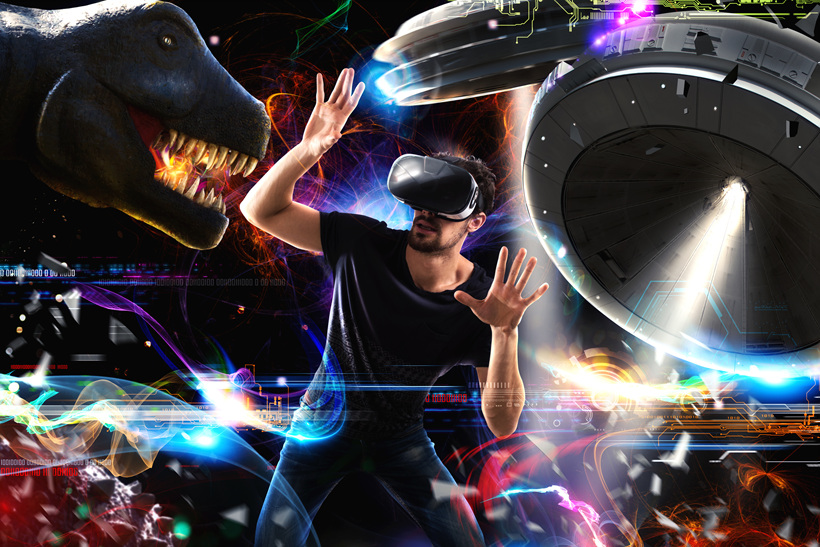
In the past, many offline gatherings of online communities were held in Dok-dabang, a coffee house located in Sinchon, Seoul. While I was sitting there waiting for my friends, I often hear interesting stories from people sitting next to me. I still remember conversations among game users of online MMORPG such as Lineage or World of Warcraft. They were talking about their in-game experience as if they had that experience in real life. Nowadays, people may take such conversations for granted. We are now way passed the time when we belittled digital experiences happening on the internet or in games.
The advent of Metaverse
We now get used to meeting with people online behind an avatar. The exchange becomes even more immersive when we add voice chatting to itNow you can feel the emotions you used to have while playing online games with friends in PC rooms, right inside your room. If the virtual world is not so different from the real world, wouldn’t it be possible to live in the virtual world? Neal Stephenson unfolded such imagination in his 1992 SF novel titled Snow Crash. The book conjured a world where all powers are privatized, and people go into the “Metaverse” – a virtual world where avatars of people mingle and have a realistic experience.

As the movie ‘Ready Player One’ depicted, it has now become a common concept, but few people thought of this concept in 1992. As soon as it was introduced, the metaverse concept inspired many developers, and a series of games developed based on this idea. The Second Life, rolled out in 2003, is a service that openly promotes that it was created under the influence of Snow Crash. Second Life is a three-dimensional social network service created by Linden Lab where users can socialize, have romantic relationships, and do business. Also, the Linden dollar, a virtual currency inside the service, allows users to buy and sell items within this space.
The term ‘Metaverse’ went viral along with the popularity of Second Life, but it was soon forgotten by people as the service faded away from people’s memory. However, COVID-19 brought up metaverse again from the forgotten world. Pandemic brought forward an era where people have meetings, study, and play in virtual spaces. NVIDIA’s CEO Jensen Huang triggered the resurgence of this trend. At GPU Technology Conference (GTC), an event for NVIDIA’s game developers, CEO Huang mentioned the metaverse while introducing a VR collaborative tool called Omniverse. He explained the omniverse would have people come and work together in virtual reality and subsequently build a metaverse depicted in novels and movies. Soon after, the term ‘metaverse’ became a trending word.
So, what is the Metaverse?
What is metaverse? The word "Metaverse" is made up of the prefix "meta" (meaning beyond) and the stem "verse" (a backformation from "universe"), but the term itself doesn’t exactly explain its actual meaning. Some call it a ‘virtual space mirroring real lives’, while others describe it as a ‘virtual world where people engage in social, economic, and cultural activities behind their avatars’. Likewise, the self-declaring metaverse tools, platforms, and services come in different shapes.

For NVIDIA, a metaverse is an online simulation and collaboration platform where people using different tools can cooperate in real-time. Microsoft and Facebook see a metaverse as the augmented/virtual reality-based platform where people play games or have meetings. In addition, entertainment businesses want to use the metaverse to create an online avatar for a celebrities’ sub-characters. Games displaying key traits of the Metaverse, such as Fortnite and Roblox, offer an in-game platform where gamers can engage inside events such as concerts and social gatherings. ZEPETO is a kind of social network service that lets users create a 3D digital character and socialize with other users. By now, you may be confused about what this is about, but it boils down to one thing - leading a real-life in a virtual world. While existing virtual worlds were fantasy spaces that realize enviable things, in reality, the metaverse is a virtual world where people come together and work, study, socialize, barter, and engage in other real-life activities. Once people start to lead a life there, the digital world will also provide business opportunities. Like Cyworld, a Korean social networking website that used ‘dotori’, a cybermoney as currency, developers can create tradable items that are only available in that virtual space. Or think of internet shopping websites, a metaverse can evolve into a promotional space where actual products are bartered.
This is how the virtual and real-world are ingrained into each other. The game Fortnite’s popularity moved up a notch by streaming the rapper Travis Scott’s concert, but the event also benefitted the hip-hop artist by launching the in-game items. Travis Scott added 1.4 million new social media followers, and his ticket demand increased by 419% after his first virtual Fortnite concert. In Japan, the VRChat app hosted a virtual event called ‘Cross Market 2’. It is an exhibition that sells a wide range of 3-D items such as avatars and avatar accessories. There, people can walk around, trade, and communicate with other participants behind their avatars. Likewise, efforts to converge virtual space with the real world are underway.
Apart from Second Life, there have been many online games offering open trade features such as all-time classic Ultima Online and Mabinogi boasting in-game fantasy life. However, interactions happening in virtual spaces are nothing more than entertainment except for trading game items in cash. Today, IT giants are tapping on metaverse technology because they want to translate such digital spaces into real-life work, conferences, education, and social bonding, leveraging the pandemic-triggered at-home era. In other words, they are exploring ways to turn virtual spaces from intriguing places to use to essential places which is more engaging and convenient to work and live remotely.
Metaverse, a life surrounded by displays

Then, how will metaverse be applied to our everyday lives? To begin with, there is ongoing research on building a digital world that replicates our reality. Just like Google Street View presents a compilation of street photos, metaverse will present a digital twin by creating a three-dimensional model of the physical world. This method allows people to live on the streets filled with real-world duplicates. There, we can collect a wide range of information and overlay them to real-life locations. The overlaid information can be recorded in the AR cloud and shared with other AR device owners. This technological trend is also fueling the development of Augmented/Mixed Reality devices.
Perhaps, we may one day live in a world without display devices. Some may think that we will usher in a world where digital information becomes so accessible that we won’t need computers, TVs, and smartphones. But that’s not true. On the contrary, I believe it’s more plausible to expect a world exposed to a host of displays except while we are asleep because we may see the world through the display of VR devices just like we see the world wearing glasses. We are looking for more convenient ways to utilize digital information. As long as we need digital information, displays will remain useful. As we gradually bring metaverse into our daily lives, we will look for better displays.

But let’s not jump to a conclusion that metaverse will remain in the mainstream for a long time. No matter how great technology is, it still requires us, humans, to use our time, but our time is limited. People do not try new technology just because it has potential. It should at least be interesting, instructive, or beneficial. Also, it should be absolutely convenient to use. You may rather use a computer instead of wearing bothering AR glasses. Also, some may still insist meeting in person is essential to do business and bloom romantic relationship. But let’s see it simply. Metaverse can be another tool in our hands to lead an easier life.
※ This article holds the editor’s opinion, and Samsung Display Newsroom’s stance or strategies are not reflected.


